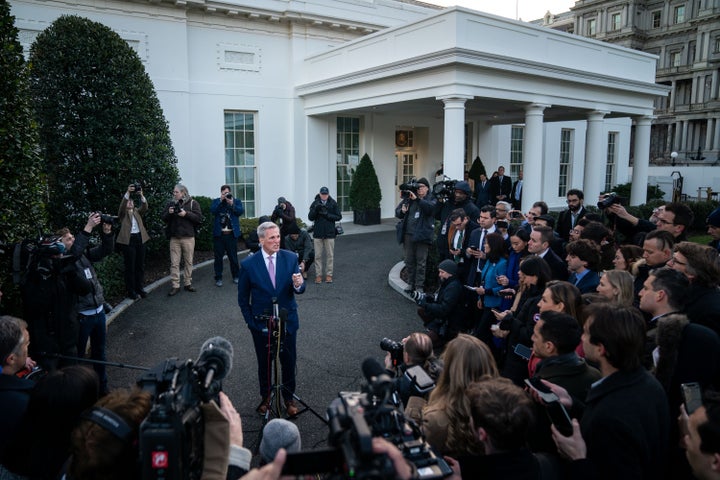Republicans in Washington have been tossing out all kinds of ideas about what they would want in return for raising the federal debt ceiling ― and the conventional wisdom has been that they have until late summer to decide.
But two economists say that’s not necessarily the case. The government could find out as soon as late April that it will no longer be able to keep borrowing or pay all the government’s bills come the first half of June, they say.
“We originally said it was a risk to be monitored. Now it’s a risk to be monitored closely,” Lou Crandall, chief economist with the financial analytics firm Wrightson ICAP, told HuffPost.
“Treasury hasn’t said that mid-June, early- to mid-June is the ‘X date,’ but I’d say there’s a 20% probability,” he said.
Nancy Vanden Houten, lead U.S. economist at the advisory firm Oxford Economics, had a similar assessment.
“I think there is a meaningful risk that the drop-dead date could occur in early June,” she said.

Both economists emphasized that June is not the most likely deadline, and both saw a much greater probability of the actual deadline still being later in the summer — late July or early August for Vanden Houten, and late July for Crandall.
But a sudden June drop-dead date to raise or suspend the debt ceiling would ramp up pressure on Washington to get its negotiating act together quickly. Not doing so could risk a potentially catastrophic default on U.S. debt, which in turn would undermine the dollar’s role as a global reserve currency.
The lumpy way in which the government’s cash flows operate is the reason for the uncertainty over when exactly a deal needs to be struck. The government borrows money from Wall Street in the form of debt, to pay tax rebates to income tax filers from January through March. (The Treasury Department estimates that borrowing will total $932 billion this quarter.)
But the cash flow reverses sharply with the arrival of April and tax payment dates for individual and corporate taxpayers. That April shower of revenue often determines whether an annual budget deficit will be larger or smaller than expected. In this case, it could determine whether Treasury will be able to make it through June without a debt limit hike.
“We originally said it was a risk to be monitored. Now it’s a risk to be monitored closely.”
- Lou Crandall, chief economist with Wrightson ICAP
The individual income tax deadline is April 18 this year instead of the traditional April 15, because of a calendar quirk. Crandall said analysts won’t know until late April or early May what the revenue picture looks like.
“The forecast cone will narrow dramatically week by week from April 15 through the end of the month,” he said.
Treasury likes to have about $600 billion in cash on hand in case the U.S. is somehow locked out of capital markets for a time, as happened briefly after Sept. 11. But Vanden Houten said Treasury’s reserve could run below $100 billion in June, “dangerously low from a risk-management perspective.”
“I think that we will have a much clearer picture at the end of April,” she said. “If individual income tax payments following the April 15 deadline were just 5% to 10% weaker than my forecast, I think the risk of Treasury running out of cash in early June would be quite elevated.”
So far, the White House and House Republicans have only publicly begun the initial steps in what is expected to be a long and likely chaotic negotiation. President Joe Biden and House Speaker Kevin McCarthy (R-Calif.) met on Feb. 1 for an initial get-together.
The White House’s opening position has been that the debt limit should not be subject to a hostage negotiation, and that implicitly threatening default is irresponsible. McCarthy has said there will not be a default, but that the administration must be open to bargaining over demands from the GOP for as-yet unspecified spending cuts.
The sluggish pace so far, hindered by Republicans failing to articulate a specific slate of demands and the White House feeling increasingly confident it has the high ground on budget issues, raises the possibility that Washington will wait for Wall Street to get nervous while Wall Street, having seen this scenario play out so often in the past, will wait for the Washington players to begin sweating.
The Treasury Department has been keeping its powder dry, running through its well-worn playbook of accounting moves to keep below the limit and making no forecasts of its drop-dead date. Treasury Secretary Janet Yellen has told Congress “it is unlikely that cash and extraordinary measures will be exhausted before early June.”
The nonpartisan Congressional Budget Office is set to release its own projections on Wednesday in conjunction with its annual economic and budget forecasts.
